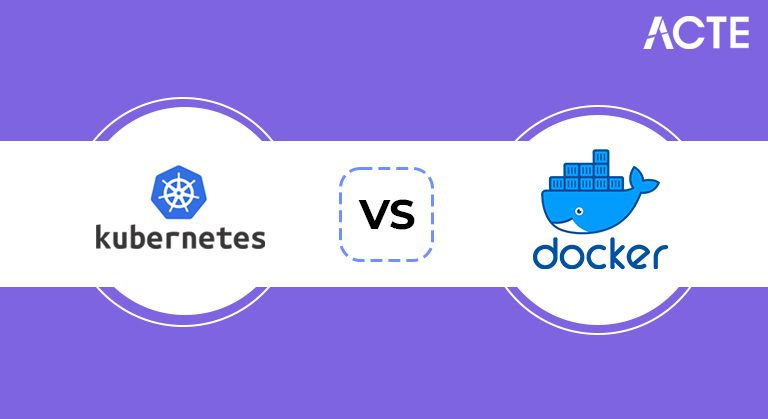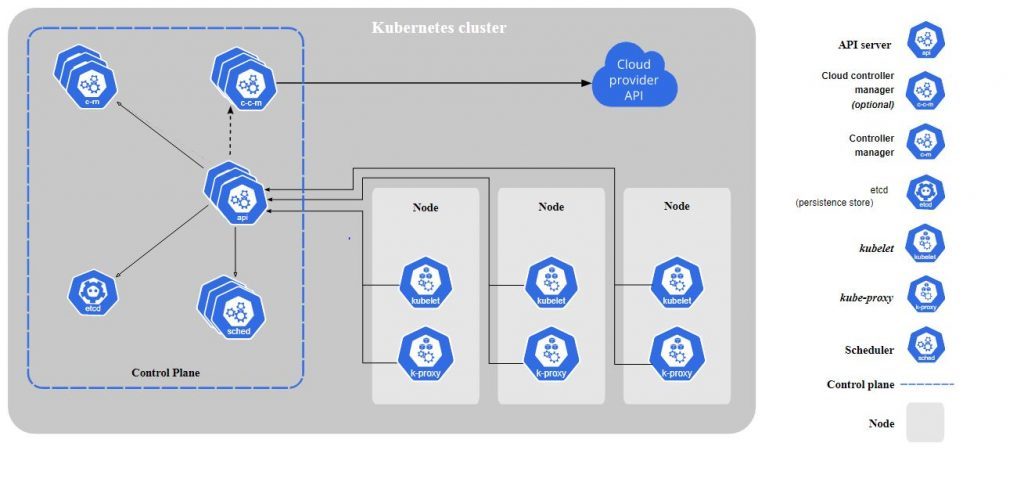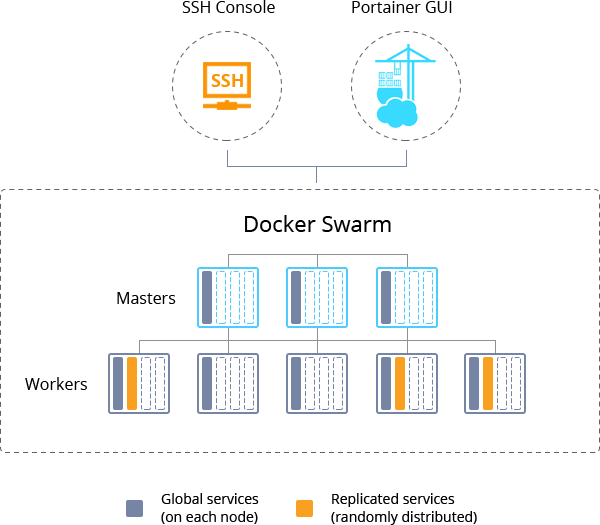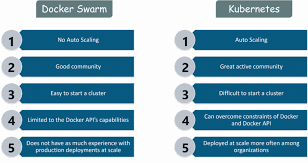
Introduction :-
Kubernetes and Docker are two of the central parts in holder organization. They have cut trustworthy specialties for them and established their situations in the Docker and the holder biological system. Both of these instruments empower you to deal with a group of servers that run at least one administrations on them. Thus, prior to bouncing into the examination part, we should get an outline of these two devices.
Kubernetes :-
Kubernetes is an open-source stage made by Google for holder arrangement activities, increasing and down, and mechanization across the groups of hosts. This creation prepared, undertaking grade, self-mending (auto-scaling, auto-replication, auto-restart, auto-situation) stage is measured, thus it tends to be used for any design organization.
Kubernetes likewise conveys the heap among holders. It means to calm the devices and parts from the issue looked because of running applications in private and public mists by putting the holders into gatherings and naming them as intelligent units. Their power lies in simple scaling, climate rationalist movability, and adaptable development.
As a stage, Docker has reformed the way programming was bundled. Docker Swarm or just Swarm is an open-source compartment organization stage and is the local grouping motor for and by Docker. Any product, administrations, or instruments that run with Docker holders run similarly well in Swarm. Likewise, Swarm uses a similar order line from Docker.
Swarm transforms a pool of Docker has into a virtual, single host. Swarm is particularly helpful for individuals who are attempting to become familiar with an organized climate or who need to stick to a straightforward sending procedure yet additionally have all the more only one cloud climate or one specific stage to run this on.
Docker Swarm :-

Kubernetes Versus Docker Swarm :-
However both the open-source coordination stages give a large part of similar functionalities, there are a few central contrasts between how these two work. Beneath here are a portion of the prominent places. This part thinks about the elements of Docker Swarm and Kubernetes and the shortcomings/qualities of picking one stage over the other.
Application definition :-
Kubernetes: An application can be sent in Kubernetes using a mix of administrations (or microservices), organizations, and units.
Docker Swarm: The applications can be conveyed as miniature administrations or administrations in a multitude group in Docker Swarm. YAML(YAML Ain’t Markup Language) documents can be used to recognize multi-compartment. Additionally, Docker make can introduce the application.
Organizing
Kubernetes: The systems administration model is a level organization, permitting all cases to collaborate with each other. The organization approaches indicate how the cases cooperate with one another. The level organization is carried out ordinarily as an overlay. The model requirements two CIDRs: one for the administrations and the other from which cases procure an IP address.
Docker Swarm: The Node joining a multitude group produces an overlay network for administrations that range each host in the docker swarm and a host-just docker span network for holders. The clients have a decision to scramble compartment information traffic while making of an overlay network by all alone in docker swarm.
Adaptability :-
Kubernetes: For appropriated frameworks, Kubernetes is a greater amount of an across the board structure. It is an intricate framework since it gives solid assurances about the group state and a bound together arrangement of APIs. This dials back holder scaling and organization.
Docker Swarm: Docker Swarm, when contrasted with Kubernetes, can convey holder a lot quicker and this permits quicker response times to scale on request.
High Availability
Kubernetes: All the units in kubernetes are conveyed among hubs and this offers high accessibility by enduring the disappointment of utilization. Load adjusting administrations in kubernetes distinguish unfortunate cases and dispose of them. Along these lines, this backings high accessibility.
Docker Swarm: As the administrations can be repeated in Swarm hubs, Docker Swarm likewise offers high accessibility. The Swarm supervisor hubs in Docker Swarm are liable for the whole bunch and handle the laborer hubs’ assets.
Compartment Setup :-
Kubernetes: Kubernetes uses its own YAML, API, and customer definitions and each of these vary from that of standard docker counterparts. In other words, you can’t use Docker Compose nor Docker CLI to characterize holders. While exchanging stages, YAML definitions and orders should be modified.
Docker Swarm: The Docker Swarm API doesn’t totally envelop Docker’s orders in general yet offers a large part of the recognizable usefulness from Docker. It upholds the vast majority of the instruments that run with Docker. By and by, in the event that Docker API is insufficient of a specific activity, there doesn’t exist a simple way around it using Swarm.

Load Balancing :-
Kubernetes: Pods are uncovered by means of administration, which can be used as a heap balancer inside the bunch. By and large, an entrance is used for load adjusting.
Docker Swarm: Swarm mode comprises of a DNS component that can be used for conveying approaching solicitations to a help name. Administrations can be doled out consequently or can run on ports indicated by the client.
Benefits of Docker Swarm
- Docker Swam is clear to introduce, particularly for those simply bouncing into the holder arrangement world. It is lightweight and simple to utilize.
- Likewise, Docker Swarm invests in some opportunity to comprehend than more intricate organization devices. It gives computerized load adjusting inside the Docker holders, though other compartment coordination devices require manual endeavors.
- Docker Swarm works with the Docker CLI, so there is no compelling reason to run or introduce the whole new CLI. Besides, it works consistently with existing Docker instruments like Docker Compose.
- Docker Swarm doesn’t need design changes in the event that your framework is now running inside Docker.
Disservices of Docker Swarm :-
- In spite of its advantages, there are a couple of weaknesses of utilizing Docker Swarm that you ought to know about.
- In the first place, it is lightweight and attached to the Docker API, which limits usefulness in Docker Swarm, contrasted with Kubernetes. In like manner, Docker Swarm’s robotization abilities are not so hearty as those presented by Kubernetes.
- Kubernetes is an open source compartment arrangement stage that was at first planned by Google to deal with their holders. Kubernetes has a more mind boggling bunch structure than Docker Swarm. It typically has a manufacturer and specialist hubs engineering separated further into units, namespaces, config maps, etc.
Benefits of Kubernetes
- It has an enormous open-source local area, and Google backs it.
- It upholds each working framework.
- It can maintain and oversee enormous structures and complex responsibilities.
- It is mechanized and has a self-recuperating limit that upholds programmed scaling.
- It has implicit observing and a wide scope of accessible incorporations.
- It is presented by each of the three key cloud suppliers: Google, Azure, and AWS.
- Due to its expansive local area backing and capacity to deal with even the most mind boggling sending situations, Kubernetes is regularly the main decision for big business advancement groups overseeing microservice-based applications.
Kubernetes offers a wide scope of advantages to groups searching for a vigorous holder arrangement device:
Drawbacks of Kubernetes :-
- It has a perplexing establishment process and a precarious expectation to learn and adapt.
- It expects you to introduce separate CLI devices and become familiar with every one of them.
- The change from Docker Swarm to Kubernetes can be muddled and hard to make due.
- In certain circumstances, Kubernetes can be excessively convoluted and lead to a deficiency of usefulness.
Regardless of its extensive list of capabilities, Kubernetes likewise has a couple of disadvantages:

Which stage would it be advisable for you to utilize?
- Both Kubernetes and Docker Swarm serve explicit use cases. Which one is best for you relies upon your association’s requirements.
- For fledglings, Docker Swarm is a simple to-utilize and straightforward answer for deal with your compartments at scale. Assuming your organization is moving to the compartment world and doesn’t have complex jobs to make due, then, at that point, Docker Swarm is the ideal decision .
- Assuming your applications are precarious and you are searching for a total bundle that incorporates observing, security highlights, self-recuperating, high accessibility, and outright adaptability, then, at that point, Kubernetes is the best decision.
- Assuming you want every one of the abilities of Kubernetes however are put off by its expectation to learn and adapt, then, at that point, K3s is a decent other option.
Conclusion:
In this article, we investigated the two essential orchestrators of the compartment world, Kubernetes and Docker Swarm. Docker Swarm is a lightweight, simple to-utilize coordination device with restricted contributions contrasted with Kubernetes. Interestingly, Kubernetes is intricate yet strong and gives self-mending, auto-scaling abilities out of the container. K3s, a lightweight type of Kubernetes confirmed by CNCF, can be the ideal decision assuming that you need the advantages of Kubernetes without all of the learning overhead.
Which organization apparatus is best for you relies upon your business needs. Consider your group’s goals and experience cautiously prior to settling on a decision. Regardless of which stage you pick, you will be all around situated to scale and deal with your containerized applications.
Kubernetes upholds greater levels of popularity with greater intricacy while Docker Swarm offers a basic arrangement that rushes to get everything rolling with. Docker Swarm has been very well known among designers who incline toward quick arrangements and effortlessness. At the same time, Kubernetes is used underway conditions by different high profile web firms running famous administrations.
Both Kubernetes and Docker Swarm can run a significant number of similar administrations yet may require somewhat various ways to deal with specific subtleties. In this way, by learning Kubernetes and Docker and looking at them for different highlights, you can settle on a choice on picking the right apparatus for your holder arrangement.





